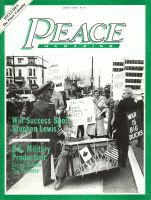
Peace Magazine March 1985, page 31. Some rights reserved.
Search for other articles by Paul Miceli here
By Ralph K. White. Don Mills: Collier Macmillan Inc., 1984. 374 pages, hardcover, $29.25.
The usual approach to problems of strategic defence is to assume that the actors involved are rational and their actions serve logical selfish interests. This leads to an analysis in which every possible strategic action is evaluated according to its expected outcome. In his book Fearful Warriors, Ralph K. White calls this kind of analysis "chessplayer's empathy" and he uses it to show that the Soviet actions most feared by the west - a nuclear first strike, an invasion of western Europe and a Mid-East invasion - are highly unlikely.
White argues, however, that such a rational approach is insufficient to explain the arms race. White therefore turns to a psychological analysis. In particular he examines the psychological fallacies which underlie the arms race. These include:
White's thesis is that the fundamental cause of these incorrect perceptions isfear. He shows that fear was a factor in many modern conflicts, notably World War I, and that it is present to a high degree in both the U.S. and the Soviet Union. Other psychological factors include "macho pride" in one s own country (the desire not to lose any competition), anger, hatred, and aggression.
The fallacies generated by these psychological conditions can only be maintained by persistent self-deception. It is well known that prior beliefs shape subsequent perceptions. An obvious example of this is the persistence of obsolete pre-nuclear military strategy in a nuclear age.
The tendency to accept only information that fits in with our prior beliefs is a known factor in psychopathology. White argues that it is also present in international conflict situations. Selective inattention is tied up with other errors such as the credulous acceptance of propaganda.
There are some problems with the factual evidence used to support White's thesis. For example, he can discuss the United States as an insider and he generally has more information about the American public than the Soviet public. However, this shortcoming does not destroy the strength of his argument.
One of White's important contributions is the idea that empathy can be applied to international relations. This is a cornerstone of his proposed solution to the arms race, as well as being crucial to his analysis, since the use of "realistic empathy" makes it possible for White to give a rational account of Soviet actions.
A more serious flaw in the book is White's failure to say more about the political systems in the two countries.
White's proposal for prevention of nuclear war includes interesting but tentative ideas, some well reasoned argument, and some ideas that would probably be unacceptable to both pro- and anti-nuclear activists. The basic principle advocated by White can be described as "minimal deterrence combined with tension reduction."
Tension reduction measures include a comprehensive test ban, a freeze agreement, a joint first-use statement and bilateral reduction of short-range weapons. The proposal for unilateral cuts in highly destabilizing MIRV and MX missiles is more controversial but White argues the case well.
Much of White's plan for deterrence is also reasonable. The main problem White's approach poses for peace activists is that he accepts the need for a minimal form of nuclear deterrence in the form of five submarine launchers.
Fearful Warriors is a useful contribution to the disarmament literature. It gives a chilling demonstration that the U.S. and the Soviet Union are in a prewar state. But it also contains a strong optimism that nuclear disaster can be avoided.

Peace Magazine March 1985, page 31. Some rights reserved.
Search for other articles by Paul Miceli here